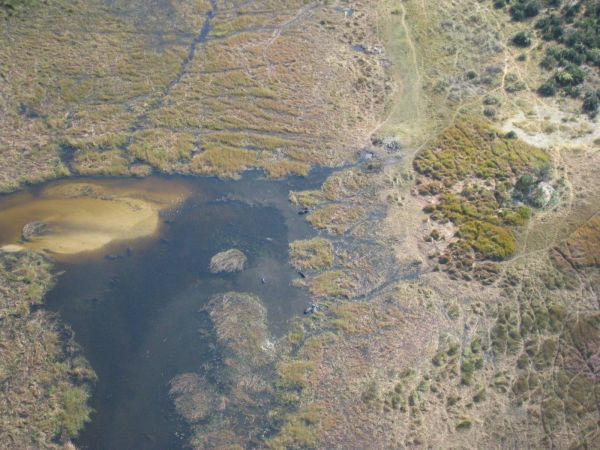To perfect our visit of the Okavango area and fill in this urge of contemplating the animals from above, we book an one-hour flight over the delta. An interesting way to understand this aquatic maze which snakes through the plain. A special moment with elephants and hippopotamuses.






Keyword - animal kingdom -
Thursday 10 July 2008
Flying over the Okavango delta
By dorian on Thursday 10 July 2008, 18:59 - RTW2-Botswana
Wednesday 9 July 2008
Mokoro trip in the Okavango delta
By dorian on Wednesday 9 July 2008, 18:53 - RTW2-Botswana
A short stop in Windhoek. Just the time to walk up the main street of the Namibian capital city, the independence avenue. A small 200000-soul city we leave in the morning to head eastwards, to Botswana. Warthogs, baboons and hornbills liven up the long straight tarmac road carved in the plain. Border crossing. The authorities stamp our passports. Our admission ticket for Botswana is validated. Namibia moves away and new adventures begin. I feel a twinge of sadness : Namibia, that was really nice!


We drive for 400 km to reach the city of Maun, a launching pad to go to the Okavango delta. The Okavango, one of the few rivers which never reaches the sea. Instead of pouring into a water expanse, the river splits into a mass of branches and canals. A huge swamp spotted with myriad of islands where the African fauna lives in peace. Elephants, antelopes, zebras, wildebeests, giraffes and hippopotamuses graze in this green delta.
To organize the visit of the delta, we stay in a nice campsite called “Back to... the old bridge backpackers”. African rhythm illustrated by the motto “hakuna matata”. Smiles, laughs, rest and joie de vivre are the bricks that make up this haven of peace.





The campsite works an upstream village called “Boro”. From the village, the locals offer mokoro (traditional canoe) trip on the Okavango delta. It's rather a trunk-carved gondola – the most recent ones are coated with a resin to make it more resistant. And the helmsman uses a long stick to go forward.
We leave the campsite by boat to reach the village. Serene navigation on the peaceful waters of the delta.
when we arrived, a lot of canoes float. A rotation system avoids the crush between the different villagers. We make the acquaintance of Moralé, our gondolier and guide for the next 2 days. We load the bags and get into the mokoro. We team up with 2 other boats which we're going to spend the 2 days with. Moralé firmly pushes the bank and we leave towards the tall grass. Silence. The pole shakes the water and the vegetation opens in front of us. We mark our print in the swamp.




we put up the camp on one of these islands. We swap our wooden boat for a pair of shoes and a pair of trousers in order to venture in this bit of land abandoned to the wildlife. A hike through the African-sunkissed scrubs. Unlike the Etosha park, no waterhole was built and the animals which populate the area live in complete freedom. We come up to a group of elephants. The mother's attitude dissuades us from walking nearer. A few steps away, zebras and wildebeests live together and help at each other. The wildebeest has a very acute eyesight when the zebra shares its sense of smell to the community.




The sun sets. We gather around the fire where our guide succinctly relates the history of Botswana and its people and starts singing the national anthem. A lively evening between laughs and cultural exchanges surrounded by some noises coming from the remotest part of the savannah.
In the morning, we take back our mokoros and make our way through the aquatic plants. Neighs rise from all around us. We come out onto a small pond where big mammals splash about. A massive head adorned with two small ears float above the water. First confrontation with a hippopotamus. Suddenly, breaking the serenity of the lake, a mass appears out of the water. One of the hippopotamuses attempts to intimidate us, it shows its annoyance. Burning desire of seeing us leaving the pond it has chosen to swim with its family.

We arrive at the village and change the mokoros for the engine-powered boat. We extend the gliding on the Okavango marsh to go back to the campsite. End of our short but nice story in the delta.


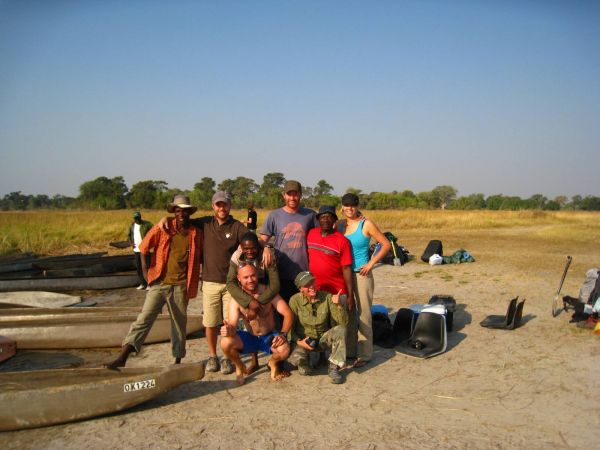


Thursday 3 July 2008
At the kingdom of Etosha
By dorian on Thursday 3 July 2008, 19:13 - RTW2-Namibia

The Waterberg created this gentle transition toward the animal kingdom. Because “Africa” rhymes with “Odysseys of wild animals”. For mammals, birds or reptiles, one of their shrines is called Etosha and roosts at the north of Namibia. This vast park gathers various habitats and encompasses the Etosha pan which gave it the name.
The sun timidly rises on the horizon, an excitement shakes us when we get in the park. It's the east entrance of Namutoni. The cameras, out of their cases, are ready to capture the slightest manifestation of wildlife. We will have only waited for about one hundred meters. A giraffe crosses the road to tear some acacias up. First view of Etosha. A youthful dream.
The opportunity to watch animals is concentrated on the waterholes. And the game consists in being at the right water point at the right moment. The first one, a tuft of grass in the middle of an aquatic ring. We stop the engine and wait. We scan the horizon and whisper about what we think to see. A hyena, head down, walks in the distance. A jackal goes near and step around the pond. A springbok gazes at itself. The discovery is progressive. The joy is constant. Each species takes part in this ecosystem. Wildebeests graze alongside the track among high grass.
The animals relentlessly follow on. We don't take off our cameras any more and our 6 eyes leap from a bush to a branch before going again to the horizon line. Sometimes multicoloured birds, twisted antlers of kudus or throng of gemsboks ; sometimes a giraffe behind a shrub which winks at us. We remain speechless, the smile screwed on our lips.

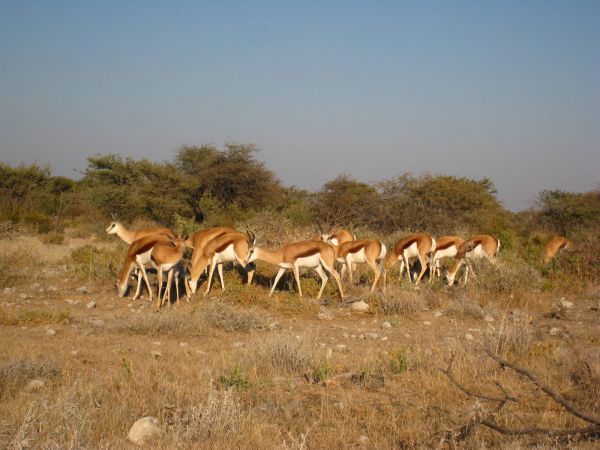











Another mythical animal comes on. A characteristic blotchiness. A horse-like body that seems familiar to us. A tribe of zebras comes to drink between two palm trees. A few meters beside, a giraffe, in an unpleasant position, shares this stock of vital liquid.
The zebras leave back and we take again the road. We drive on the giraffes' land. Long necks appear on the horizon. An elephant slowly passes. With a heavy step, it heads for the waterhole. We crawl along and the long spotted necks keeps on swinging, not synchronized with the rest of the body. Concert of colours and movements which engraves on our pupils.
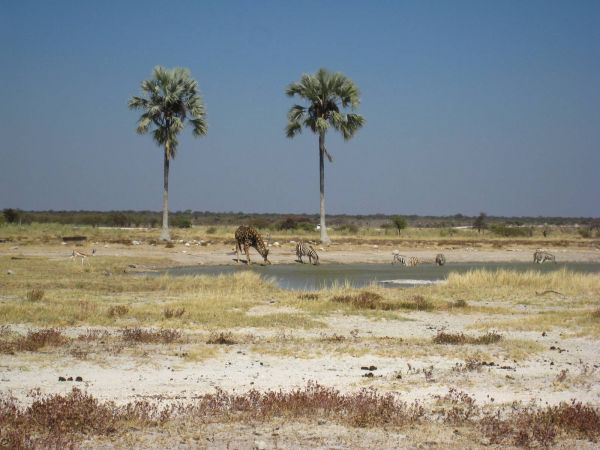
















We go back to the Halali campsite, one of the 3 campsites nestled in the park. We remain in the cocoon. At the bottom of the campsite, a waterhole was built. A terrace looks over the place and the Halali's dwellers come to try their luck, the eye riveted on the other side of the fence. And this first day ends in a blaze of glory with a nocturnal fight between two black rhinoceroses
Happy to hear the alarm-clock which resounds at 6 o'clock in the morning. The call of savannah rang out. We wait for the opening of the campsite gate and dash off to the first waterhole. Zebras and springboks share our everyday life. An elephant gives itself a shower of dust. We recite the lessons of the day before. All this diversity of animals prints our retina. We sail from a water point to another one. At the sunset, a herd of about thirty elephants reserved the pond. The colossuses play and delight us.







Our third day in Etosha starts facing a lion. One of the “big five” - subjective ranking of the 5 most dangerous animals. The lion, for its exceptional ability to attack its prey; the leopard for its camouflage ability among the high grass or at the top of a tree and its ability to swoop down on its prey; the black rhinoceros for its unpredictable mood and its ability to blindly charge at its enemy; the elephant for its prodigious ability to smash whatever faces it when it feels in danger and; the buffalo, perhaps the most dangerous one, with an impressing faculty to turn against the predator or its attacker when it's wounded and charges at the latter with all its strength even if it had to die.
The lion stands up and walks toward us, I think it's wiser to close the window... The feline crosses the track and heads for the waterhole to quench its thirst. The king of animals drives everybody away. A few mischievous springboks graze about one hundred meters away. The profusion of animals continues, zebras, gemsboks, wildebeests, ostriches, hornbills, secretary birds, kudus come to the water point in ever-greater number.


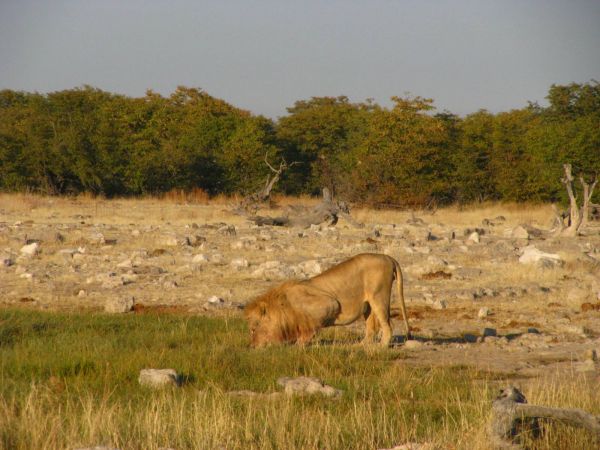








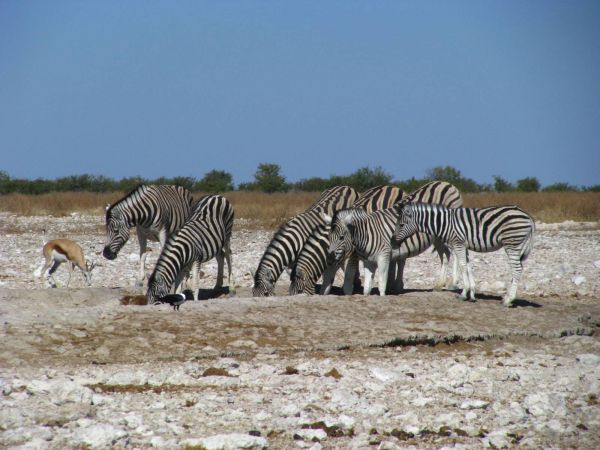




A couple of mongooses and a squirrels family accompany our last hour in the park. Small animals, full of vivacity before driving back to say goodbye to the master of the mammals, the elephant.








Un combat d'éléphants en guise de bouquet final...
We get out of the park for some new adventures. But something indescribable remains. A blend of husky cries, pied colours, rolling gaits, graceful flights and savannah smells.
« previous entries - page 4 of 7 - next entries »
